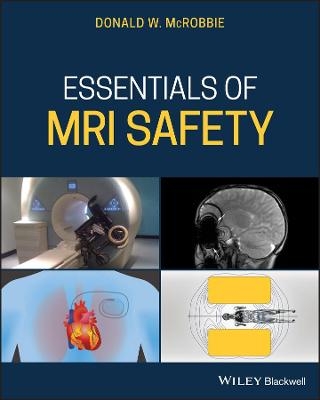
Essentials of MRI Safety
Wiley-Blackwell (Verlag)
978-1-119-55717-3 (ISBN)
Complex equations and models are stripped back to present the foundations of theory and physics necessary to understand each topic, from the basic laws of magnetism to fringe field spatial gradient maps of common MRI scanners. Written by an internationally recognised MRI author, educator, and MRI safety expert, this important textbook:
Reflects the most current research, guidelines, and MRI safety information
Explains procedures for scanning pregnant women, managing MRI noise exposure, and handling emergency situations
Prepares candidates for the American Board of MR Safety exam and other professional certifications
Aligns with MRI safety roles such as MR Medical Director (MRMD), MR Safety Officer (MRSO) and MR Safety Expert (MRSE)
Contains numerous illustrations, figures, self-assessment tests, key references, and extensive appendices
Essentials of MRI Safety is an indispensable text for all radiographers and radiologists, as well as physicists, engineers, and researchers with an interest in MRI.
DONALD W. MCROBBIE has more than thirty years' experience in MRI safety. He is currently Adjunct Associate Professor, Discipline of Medical Physics in the School of Physical Sciences at the University of Adelaide, Adelaide, Australia.
Foreword ix
Acknowledgments xi
Chapter 1 Systems and safety: MR hardware and fields 1
Introduction 1
Overview of MRI operation 3
MRI hardware 10
Electromagnetic fields 16
Other medical devices 24
Conclusions 25
Chapter 2 Let’s get physical: fields and forces 27
Basic laws of magnetism 27
Magnetic materials 32
Forces and torque 39
Lorentz and hydrodynamic forces 50
Laws of induction 51
Conclusions 57
Chapter 3 Bio‐effects 1: static field 61
Introduction 61
Physical mechanisms 61
Cellular effects 67
Animal effects 69
Human physiological effects 70
Acute sensory effects 70
Epidemiology 70
Cognitive effects 74
Static field exposure limits 74
Conclusions 74
Chapter 4 Bio‐effects 2: time‐varying gradient fields 79
Introduction 79
Physical interaction 79
ELF time‐varying magnetic field effects 83
Magnetic stimulation 86
Peripheral nerve stimulation in MRI 96
Exposure limits 99
Conclusions 102
Chapter 5 Bio‐effects 3: radio‐frequency fields 107
Introduction 107
Physical interaction 107
Tissue heating 112
Biological effects 118
RF exposure limits 124
Controlling SAR in practice 127
Conclusions 132
Chapter 6 Acoustic noise 137
Introduction 137
Generation of acoustic noise in MRI 137
Measuring noise: dB(A), dB(C), dB(Z) 138
Anatomy and physiology of human hearing 143
MRI noise exposure 146
Reducing acoustic noise in practice 150
Hearing protection 151
Acoustic noise limits 155
Conclusions 158
Chapter 7 Pregnancy 161
Introduction 161
Cellular effects and animal studies 161
Human studies and epidemiology 162
Gadolinium‐based contrast agents 164
Exposure limits and guidance 166
Conclusions 169
Chapter 8 Contrast agents 173
Introduction 173
Physical and chemical properties 173
Contrast reactions and adverse events 180
Pregnancy and lactation 186
Conclusions 186
Chapter 9 Passive implants 191
Introduction 191
Risks from passive implants 191
ASTM testing 209
Examples of passive implants 214
Artefacts 218
Conclusions 221
Chapter 10 Active implants 227
Introduction 227
Risks from active implants 227
Pacemakers and ICDs 236
Neurostimulators 243
Cochlear implants 249
Endoscopic cameras 253
Implantable infusion pumps 253
Keeping within the conditions 255
Conclusions 257
Chapter 11 Would you scan this? Understanding the conditions 263
Introduction 263
MRI conditions 263
Understanding fringe field spatial gradient maps 265
Understanding RF conditions 275
Gradient slew rate condition 278
More examples 279
Off‐label scanning 281
What to do when you do not know the conditions? 281
Conclusions 285
Chapter 12 Location, location, location: suite design 289
Introduction 289
ACR zoning scheme 289
Fringe field 292
Helium exhaust and quench pipe 292
Security 296
Safety features 297
MRI project management 301
Specialist systems 302
Conclusions 303
Chapter 13 But what about us? Occupational exposure 307
Introduction 307
Occupational exposure limits 307
National and international limits 308
Surveys of occupational exposure levels 313
Survey instrumentation 317
Incidence of bio‐effects among magnet facility and MR workers 317
Conclusions 317
Chapter 14 Organisation and management 321
Introduction 321
Roles in MR safety 321
Policy and safety documentation 324
Checklist and screening 326
Incidents 328
Emergencies 329
Training 330
Accreditation and certification 331
Standards and guidance 333
Exposure limits 337
Conclusions: the last word 337
Appendix 1 One hundred equations you need to know 341
Maxwell’s equations 341
Magnetic field induction 342
Magnetic materials 345
Forces and torque 345
Forces on moving charges 350
Laws of induction 351
RF induction from the radiofrequency field 352
SAR and tissue heating 354
Appendix 2 Maths toolkit 357
Coordinate systems 357
Vector algebra 358
Vector calculus 360
Appendix 3 Symbols and constants 363
Answers to revision questions 367
Index 369
| Erscheinungsdatum | 29.06.2020 |
|---|---|
| Verlagsort | Hoboken |
| Sprache | englisch |
| Maße | 203 x 252 mm |
| Gewicht | 930 g |
| Themenwelt | Medizin / Pharmazie ► Allgemeines / Lexika |
| Medizin / Pharmazie ► Medizinische Fachgebiete | |
| ISBN-10 | 1-119-55717-8 / 1119557178 |
| ISBN-13 | 978-1-119-55717-3 / 9781119557173 |
| Zustand | Neuware |
| Haben Sie eine Frage zum Produkt? |
aus dem Bereich


